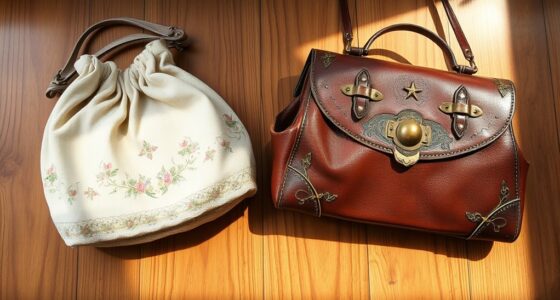The history of the clutch bag begins in Victorian society, where it served as a discreet holder for dance cards and essentials at social events, made from luxurious materials to indicate wealth. Over time, it evolved into a fashion statement, influenced by Art Deco’s geometric designs, post-war glamour, and celebrity red carpet appearances. Today, its timeless appeal combines classic craftsmanship with modern innovation—discover how this elegant accessory continues to adapt and captivate across eras.
Key Takeaways
- Clutch bags originated in Victorian society as discreet accessories signaling social status, crafted from luxurious materials like silk and velvet.
- They served practical roles during social events, managing essentials like dance cards while matching formal attire with embellishments.
- Over time, clutch bags evolved from functional items to bold fashion statements, incorporating new fabrics, metallics, and decorative details.
- The Art Deco era popularized geometric, luxurious designs with exotic materials, reflecting opulence and cultural influences of the time.
- Today, clutches are iconic on red carpets, influenced by celebrity styles and evolving towards sustainable, minimalist, and versatile designs.
Origins in Victorian Society
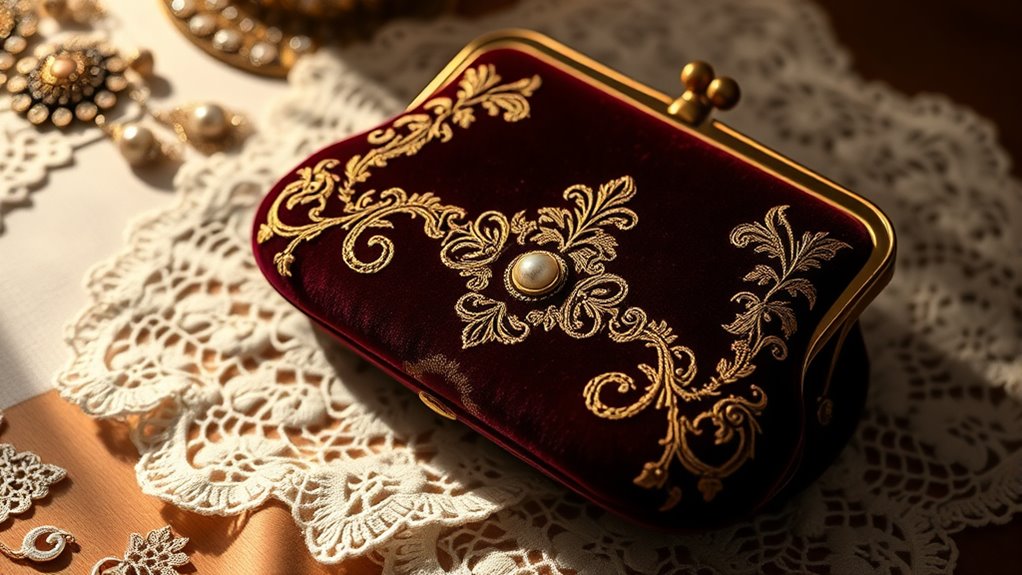
Clutch bags have their roots firmly planted in Victorian society, where fashion and practicality began to intersect. During this era, Victorian etiquette emphasized discreetness and elegance, guiding women to carry small accessories that complemented their attire without drawing attention. These bags quickly became social status symbols, signaling wealth and refinement. They were crafted from luxurious materials like silk, velvet, and embroidered fabrics, often decorated with intricate details. The size and quality of a clutch indicated a woman’s social standing, making it more than just a practical item. Instead, it served as a subtle display of taste and class. As Victorian society evolved, these small bags maintained their role as symbols of sophistication, bridging fashion and social hierarchy seamlessly. Their popularity persisted into the early 20th century, adapting to changing fashion trends and social norms, especially as fashion accessories became more expressive of individual identity. Additionally, the transition from ornate Victorian designs to more streamlined styles reflected broader shifts in fashion history.
The Practical Role of Dance Card Bags
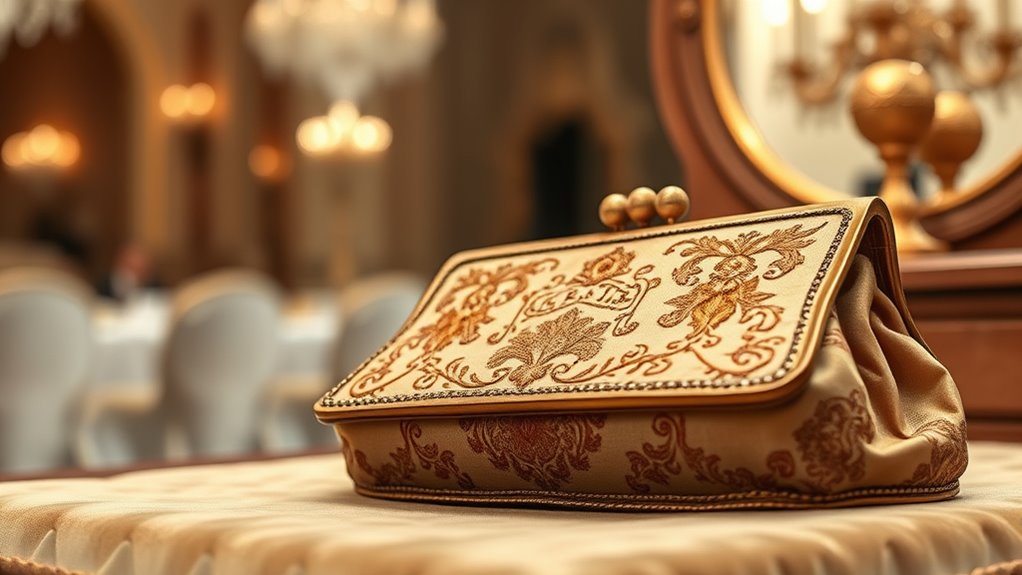
During the lively social events of the early 20th century, women relied on dance card bags not just as elegant accessories but as essential tools for managing their evening. These bags often featured embellished detailing, making them visually appealing and matching the formality of the occasion. They came in a variety of color variations, allowing you to coordinate with your dress or stand out subtly. The practical role was clear: securely holding your dance card, a pencil, and small essentials like lipstick or a handkerchief. The compact size ensured you could navigate crowded ballrooms easily. By combining function with decorative elements, dance card bags became indispensable for socializing while adding to your overall ensemble. They balanced elegance with practicality, helping you stay organized without sacrificing style. Incorporating internal company hackathons can also inspire innovative ideas, much like how dance card bags exemplified the perfect blend of utility and elegance. The evolution of these bags reflects a broader trend of merging fashion and function, which continues to influence modern accessories, especially in the realm of personal style and utility. Additionally, the use of durable yet stylish materials in their construction demonstrates an early understanding of material innovation, which remains relevant in today’s accessory design. Furthermore, the craftsmanship involved in creating these bags often incorporated attention to detail, emphasizing quality and durability that set the standard for future accessory designs.
Transition Into Fashion Statements of the 20TH Century
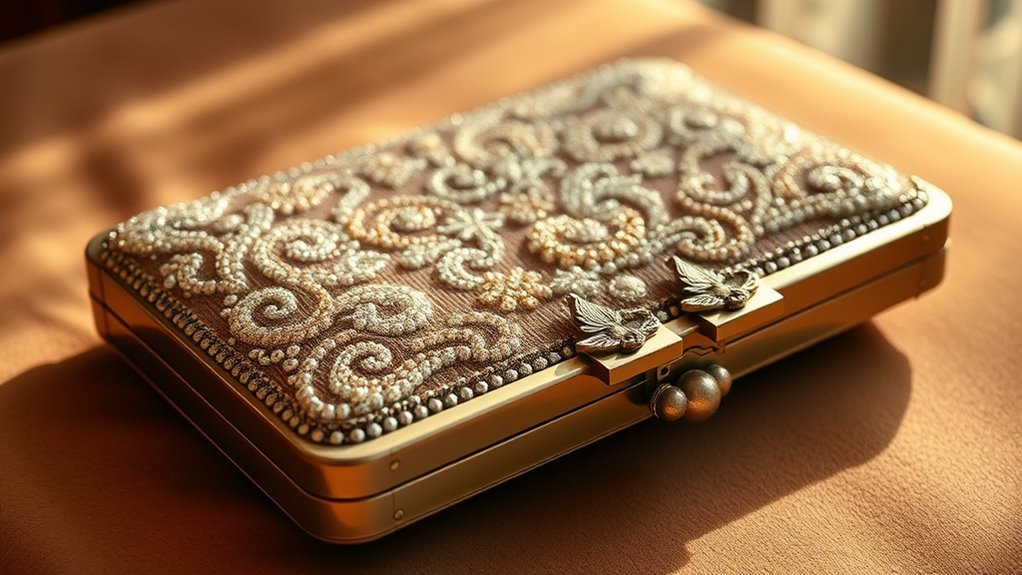
As the 20th century unfolded, handbags evolved from simple functional accessories into bold fashion statements that reflected changing social attitudes and design innovations. You can see vintage charm in the elegant, often ornate details that made these bags stand out. Material innovation played a key role too; designers experimented with new fabrics like plastic, metal accents, and synthetic leathers, making bags lighter and more versatile. Clutches shifted from purely practical items to symbols of glamour, especially on red carpets. They became expressive accessories that showcased personal style and social status. This shift marked a move toward individuality and sophistication, transforming the clutch from a discreet necessity into an essential part of fashion history. Additionally, understanding the relationship between design trends and cultural shifts helps explain how handbags became iconic fashion statements. The integration of vintage elements also contributed to the nostalgic appeal of classic clutch designs, bridging past and present styles. Recognizing these fashion evolutions allows us to appreciate the clutch’s significance as a cultural artifact. Moreover, the influence of social movements during this period further shaped handbag design and its role in expressing identity.
Art Deco and the Rise of Stylish Clutch Designs

The Art Deco movement, flourishing in the 1920s and 1930s, revolutionized clutch designs by emphasizing geometric shapes, bold lines, and luxurious materials. You’ll notice how these elements brought a new level of vintage elegance to accessories. Art Deco clutches often feature:
- Sleek, symmetrical patterns that highlight modernity
- Rich materials like enamel, gold, and exotic woods
- Decorative accents such as inlays, filigree, and gemstones
These features made clutches more than just functional; they became statement pieces reflecting sophistication and glamour. The style captured the spirit of an era obsessed with luxury and innovation. As a result, Art Deco clutches set the stage for timeless, stylish designs that continue to inspire today’s fashion. Notably, the influence of the wealth of female singers of the era helped popularize luxurious accessories, inspiring designers to incorporate opulent elements into everyday fashion. Additionally, the use of luxurious materials like gold and exotic woods elevated these accessories to a high-art status, making them highly coveted collectibles. During this period, the rise of tuning trends in various industries reflected a broader cultural fascination with combining artistry and technology. Furthermore, the emphasis on craftsmanship and detail underscored the movement’s dedication to artistic innovation, which remains influential in modern accessory design. Moreover, the design principles of the Art Deco style continue to inform contemporary interpretations of vintage glamour.
Post-War Glamour and the Evolution of Material Choices
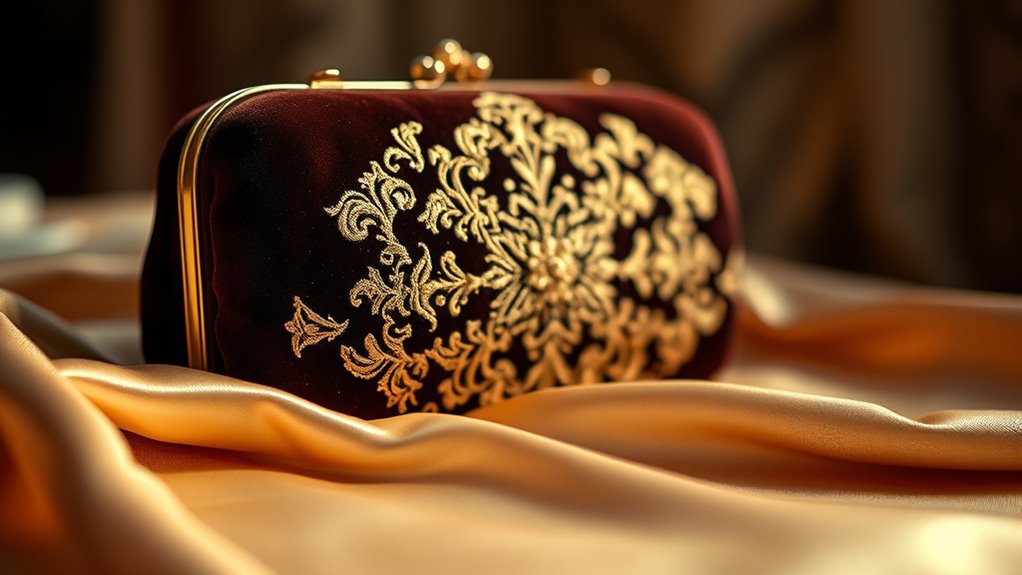
After the war, glamour returned, and designers experimented with new materials for clutch bags. Luxurious fabrics like velvets and silks made a comeback, while metallic finishes and plastics gained popularity for their modern appeal. However, material shortages pushed creators to innovate, shaping the unique looks of post-war clutch designs. material shortages prompted designers to explore unconventional options, leading to a diverse range of textures and styles.
Luxurious Fabric Trends
Following World War II, fashion shifted toward luxury and glamour, influencing the fabrics used in clutch bags. This era embraced material innovation, leading to new textures and styles. You’ll notice three key trends: 1. Rich velvets and silks became staples, emphasizing opulence. 2. Embellished fabrics with beads, sequins, and embroidery added glamour. 3. Faux materials gained popularity, offering affordable luxury without sacrificing style. These luxurious fabrics not only elevated the clutch’s appearance but also reflected the post-war desire for elegance and indulgence. material innovation played a significant role in expanding the options available to designers, enabling more creative expressions. The focus was on crafting statement pieces that showcased craftsmanship and innovation, transforming clutch bags into symbols of sophistication. Additionally, understanding prophetic dreams can inspire designers to incorporate symbolic motifs into their creations, adding a layer of meaning and cultural depth. Incorporating luxury fabrics into designs further elevated the status of clutch bags, making them coveted accessories for glamorous occasions. The development of textile technology during this period also contributed to the variety and quality of materials available. This evolution set the stage for future material choices, blending tradition with modernity in the pursuit of glamour, while space-saving techniques allowed for more functional and versatile designs.
Metallic and Plastic Use
In the post-war era, designers turned to metallic finishes and plastic embellishments to achieve eye-catching glamour and innovation in clutch bags. Metallic finishes gave bags a sleek, modern look, reflecting the optimism and fascination with new technology. Gold, silver, and chrome hues became popular, adding a touch of luxury to everyday accessories. Plastic embellishments, on the other hand, offered versatility and affordability, allowing designers to experiment with shapes, textures, and colors. Transparent plastics and molded designs created futuristic styles that captured the spirit of the era. This shift in material choices marked a move away from traditional fabrics, emphasizing bold, innovative aesthetics. You’ll notice that these materials helped clutch bags become statement pieces, blending practicality with a sense of modern glamour.
Post-War Material Scarcity
The post-war period brought significant material shortages that forced designers to rethink their choices, transforming the glamour associated with clutch bags. You notice how resourcefulness became essential, leading to innovations in vintage craftsmanship and ethical sourcing. Instead of luxurious fabrics, designers embraced alternative materials, such as:
- Repurposed textiles from wartime surplus
- Faux leathers and synthetic materials
- Recycled metals and embellishments
This shift pushed the industry toward sustainable practices, emphasizing quality over quantity. You see how scarcity spurred creativity, making clutch bags more accessible and eco-conscious. The focus moved from opulence to practicality, without sacrificing style. Such adaptations ultimately laid the groundwork for modern eco-friendly and ethically sourced designs, blending vintage craftsmanship with a renewed sense of responsibility.
The 1960s and the Boom of Iconic Clutch Styles
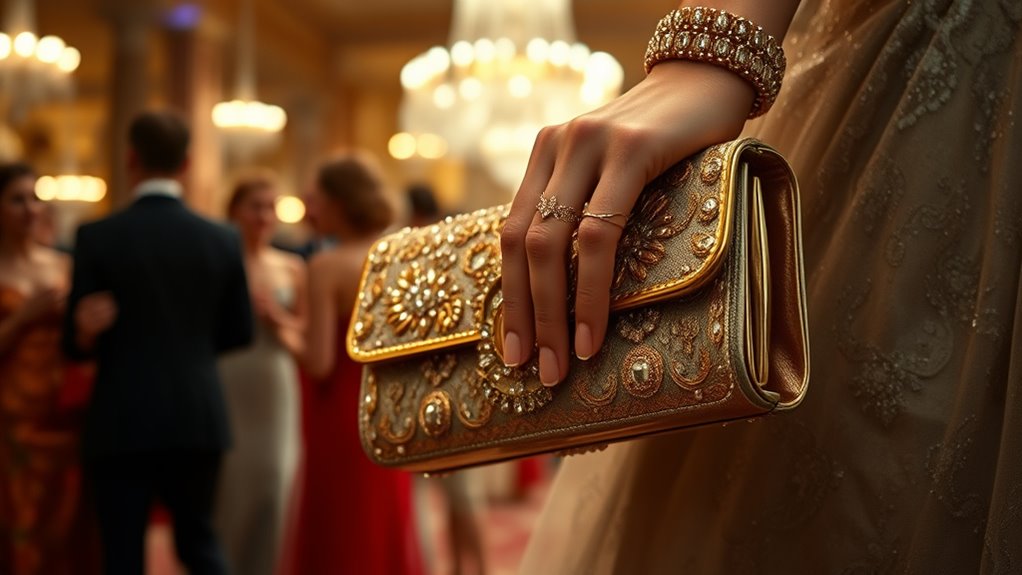
As the 1960s unfolded, clutch bags surged in popularity, becoming essential accessories that reflected the decade’s bold fashion statements. You notice that vintage charm is alive in the sleek, geometric designs and playful shapes that define this era. Clutches became more than just accessories—they carried cultural symbolism, representing independence and modern femininity. Bright colors, bold patterns, and innovative materials captured the spirit of the swinging sixties, making the clutch a statement piece for both day and night. You’ll see how designers embraced new styles, blending elegance with youthful rebellion. These bags weren’t just practical; they embodied the cultural shifts and artistic experimentation of the decade, cementing their place as iconic symbols of 1960s fashion.
The Red Carpet Era and Celebrity Influence
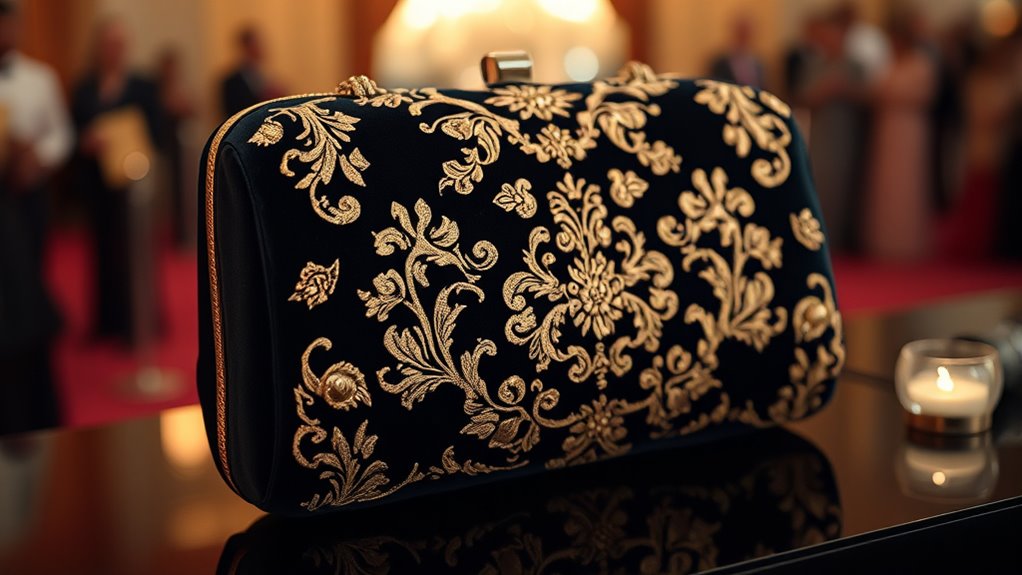
When celebrities step onto the red carpet, their clutch choices often set new fashion trends. You notice how certain styles instantly become must-haves, influencing what’s available in stores. Their influence makes clutch bags not just accessories but symbols of glamour and status.
Celebrity Style Impact
During the Red Carpet Era, celebrities have wielded undeniable influence over fashion trends, elevating clutch bags from practical accessories to status symbols. Their choices showcase vintage charm and cultural symbolism, making a statement beyond function. You notice that:
- Iconic stars often carry signature designs, shaping public perception.
- Designers create limited editions inspired by celebrity favorites, fueling exclusivity.
- The clutch’s role shifts from simple utility to a reflection of personality and status.
This influence solidifies the clutch’s place in high fashion, turning it into a symbol of elegance and sophistication. As you observe celebrity choices, you realize how their style impacts trends, inspiring others to adopt similar vintage-inspired or culturally meaningful accessories, reinforcing the clutch’s status as an iconic fashion statement.
Red Carpet Trends
The Red Carpet Era transformed clutch bags into must-have accessories, with celebrities showcasing them as symbols of glamour and personal style. Today, trends emphasize sustainable materials and minimalist designs, aligning elegance with eco-consciousness. Celebrities often select sleek, understated clutches crafted from vegan leather or recycled fabrics, highlighting a shift toward environmentally friendly choices. These trends keep the focus on clean lines and versatile accessories that complement bold outfits without overpowering them. The table below summarizes key aspects of current red carpet clutch trends:
| Trend Focus | Characteristics |
|---|---|
| Sustainable materials | Vegan leather, recycled fabrics |
| Minimalist designs | Sleek, simple shapes, understated elegance |
| Celebrity influence | Trendsetters showcasing eco-friendly accessories |
| Style versatility | Suitable for both glamour and everyday use |
Modern Innovations and Designer Collaborations
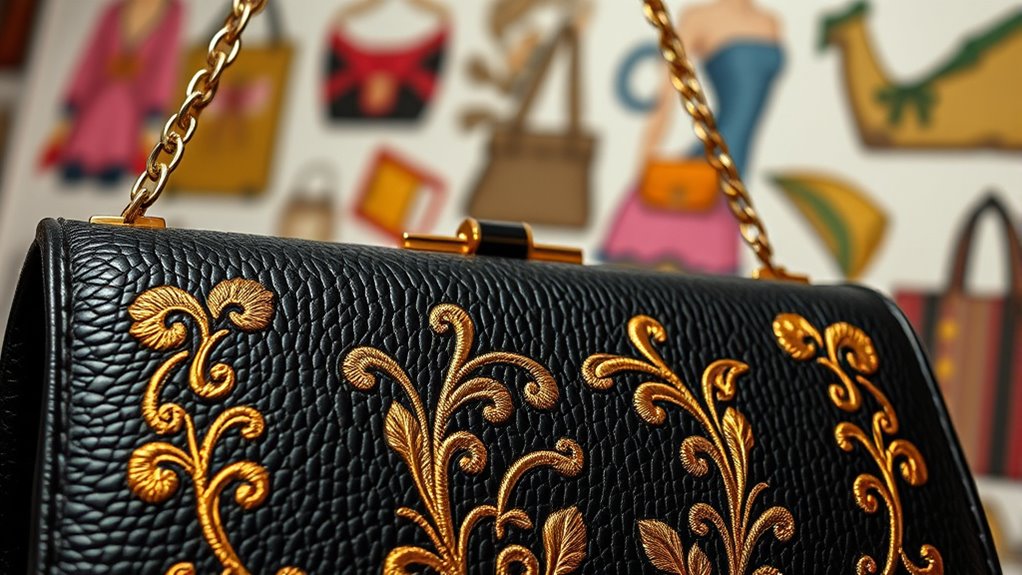
Modern innovations have transformed clutch bags from simple accessories into statements of technological and artistic achievement. Designers now focus on sustainable materials, making eco-friendly choices without sacrificing style. Collaborations between high-end brands and artists introduce unique, limited-edition pieces that stand out on any occasion. You’ll notice three key trends:
- Use of sustainable materials like recycled leather and bio-based fabrics
- Emphasis on minimalist designs that combine function and elegance
- Integration of smart technology, such as wireless charging or LED accents
These innovations allow you to enjoy chic, environmentally conscious accessories that are also cutting-edge. Designer collaborations push boundaries, blending art with practicality. It’s clear that modern clutch bags are more than just fashion—they’re a reflection of innovation and ethical values.
The Clutch Bag in Contemporary Fashion
Today’s clutch bags showcase exciting material choices, from sleek leather to glittering metallics and innovative fabrics. You’ll notice how celebrities influence current styles, making certain designs instantly iconic. These trends keep the clutch bag at the forefront of modern fashion, blending tradition with bold new expressions.
Modern Material Choices
As designers explore innovative materials, clutch bags have evolved beyond traditional leather and fabric to include a wide range of contemporary options. You now see sustainable materials like cork, Piñatex, and recycled plastics transforming the landscape. Technological innovations also play a role, enabling new textures and finishes. Here are three key trends:
- Sustainable materials reducing environmental impact
- Use of recycled and upcycled fabrics for eco-conscious designs
- Advanced manufacturing techniques enhancing durability and style
These choices let you express individuality while supporting eco-friendly fashion. Modern material options expand your possibilities, making clutch bags more versatile, stylish, and responsible. By choosing these innovative materials, you contribute to a more sustainable fashion future without sacrificing aesthetic appeal.
Celebrity Style Influence
Celebrity style has a powerful influence on how clutch bags are embraced in contemporary fashion. When stars showcase vintage elegance with sleek, handcrafted designs, you feel inspired to elevate your look. Their red carpet choices spark trends, making classic silhouettes and craftsmanship revival highly desirable. Whether it’s a minimalist satin clutch or an embellished piece, celebrities set the tone for stylish sophistication. This influence creates a ripple effect, encouraging you to seek bags that blend timeless charm with modern flair. The table below highlights some iconic moments:
| Celebrity | Clutch Style | Impact |
|---|---|---|
| Audrey Hepburn | Elegant satin, vintage appeal | Inspired timeless grace |
| Rihanna | Bold statement, craftsmanship revival | Redefines modern glamour |
| Meghan Markle | Minimalist, refined design | Elevates understated chic |
| Lady Gaga | Extravagant, artistic creations | Celebrates craftsmanship |
Future Trends and the Enduring Allure of the Clutch
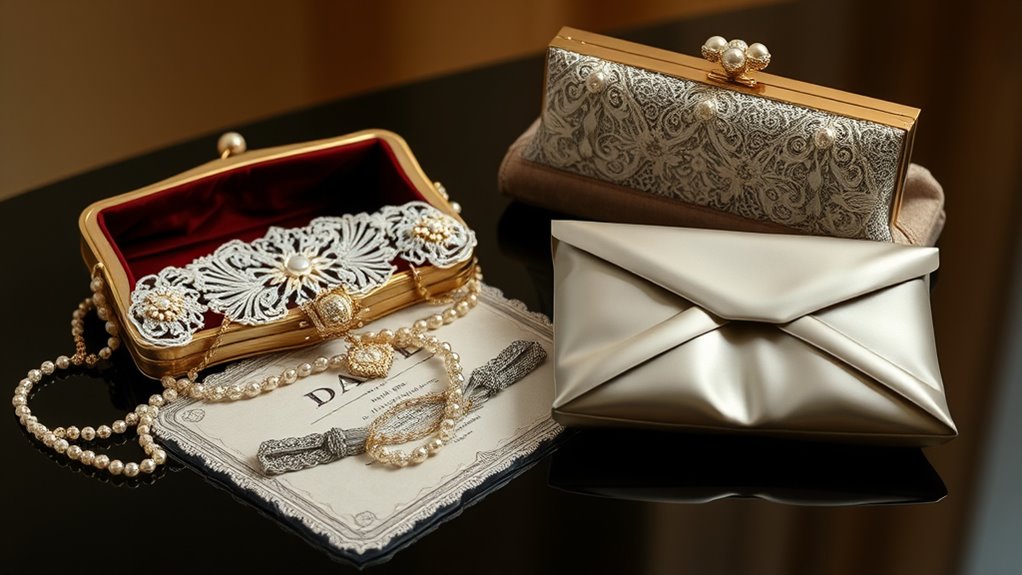
Although fashion trends evolve rapidly, the clutch’s timeless appeal continues to captivate designers and enthusiasts alike. Future trends focus on sustainability and innovation, guaranteeing the clutch remains relevant. You’ll see more designers using sustainable materials like recycled leather and eco-friendly fabrics, reflecting a commitment to environmental responsibility. Technological integrations are also on the rise, with features like built-in chargers and smart tracking. To stay ahead, consider these trends:
- Embracing sustainable materials for eco-conscious consumers
- Incorporating technological features for added convenience
- Blending classic craftsmanship with modern innovation
These elements ensure the clutch remains both stylish and functional, preserving its allure for generations to come. The enduring charm of the clutch lies in its ability to adapt while maintaining its elegance.
Frequently Asked Questions
How Did Clutch Bags Influence Women’s Social Status Historically?
Clutch bags historically impacted your social status by serving as a key fashion symbol. When you carry a stylish clutch, you showcase sophistication and awareness of trends, which can elevate your social standing. These bags often signaled wealth and class, especially during the Victorian and modern eras. Their presence in social settings reinforced your place within high society and demonstrated your connection to fashion symbolism and status.
What Materials Were Traditionally Used in Victorian Dance Card Bags?
You notice that Victorian dance card bags were crafted with exquisite Victorian craftsmanship, emphasizing elegance and detail. They traditionally used luxurious materials like silk, velvet, and satin for the fabric, often adorned with intricate fabric embellishments such as lace, embroidery, or beading. These choices reflected the era’s emphasis on refinement and social status, making the bags not just functional accessories but also symbols of sophistication and fashion.
How Did Cultural Shifts Affect Clutch Bag Designs Across Eras?
You see, cultural shifts greatly influence clutch bag designs over time, shaped by changing fashion trends and evolving gender symbolism. During the Roaring Twenties, bags became more glamorous, reflecting newfound freedom, while in the 1960s, playful and bold styles emerged. Today, modern designs blend versatility with statement pieces, embodying contemporary attitudes towards gender roles and self-expression. Your clutch becomes a reflection of society’s shifting values and aesthetic preferences across eras.
Which Designers Pioneered the Most Iconic Clutch Styles?
You’ll find that designers like Judith Leiber, with her luxurious branding and intricate craftsmanship, pioneered iconic clutch styles that became symbols of glamour. Celebrities often influence these designs, elevating them to fashion must-haves. Brands like Chanel and Hermès also set trends with their timeless, elegant clutches. Their innovative shapes, materials, and celebrity endorsements help define what makes a clutch style truly iconic in the fashion world.
Are Modern Clutch Bags Environmentally Sustainable?
You might wonder if modern clutch bags are environmentally sustainable. Many brands now focus on sustainable materials like recycled leather, cork, or plant-based fabrics. They also prioritize eco-friendly production processes that reduce waste and carbon footprints. By choosing these eco-conscious options, you help support sustainability efforts in fashion, ensuring your stylish clutch aligns with environmental values. So, yes, many modern clutch bags can be both chic and environmentally responsible.
Conclusion
As you carry a clutch, you hold more than just a bag—you carry history’s whispers of elegance and transformation. It’s a symbol of your style’s journey, from Victorian dance cards to red carpet flashes. Each clutch is a tiny vessel of stories, dreams, and glamour, reminding you that fashion’s true charm lies in its ability to evolve while keeping the timeless allure alive. Embrace it, and let your clutch be your personal legacy.


